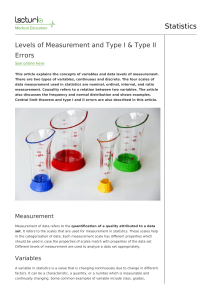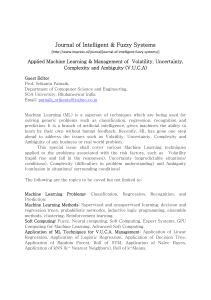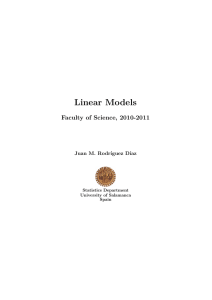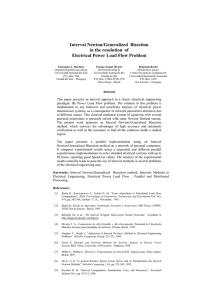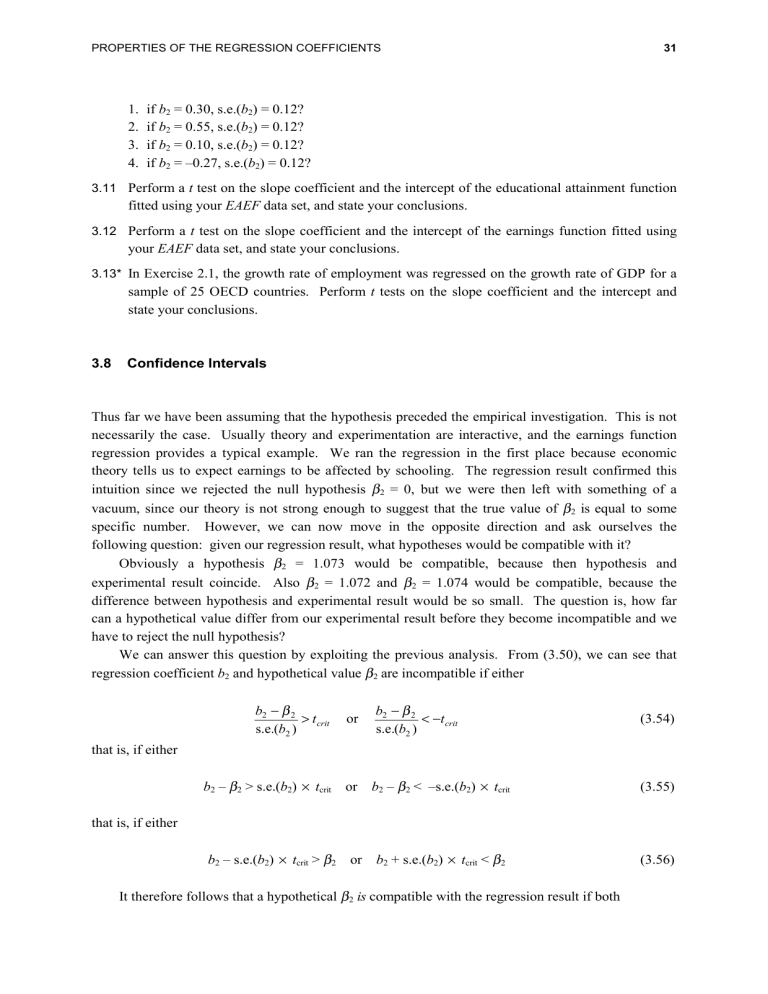
PROPERTIES OF THE REGRESSION COEFFICIENTS 1. 2. 3. 4. 31 if b2 = 0.30, s.e.(b2) = 0.12? if b2 = 0.55, s.e.(b2) = 0.12? if b2 = 0.10, s.e.(b2) = 0.12? if b2 = –0.27, s.e.(b2) = 0.12? 3.11 Perform a t test on the slope coefficient and the intercept of the educational attainment function fitted using your EAEF data set, and state your conclusions. 3.12 Perform a t test on the slope coefficient and the intercept of the earnings function fitted using your EAEF data set, and state your conclusions. 3.13* In Exercise 2.1, the growth rate of employment was regressed on the growth rate of GDP for a sample of 25 OECD countries. Perform t tests on the slope coefficient and the intercept and state your conclusions. 3.8 Confidence Intervals Thus far we have been assuming that the hypothesis preceded the empirical investigation. This is not necessarily the case. Usually theory and experimentation are interactive, and the earnings function regression provides a typical example. We ran the regression in the first place because economic theory tells us to expect earnings to be affected by schooling. The regression result confirmed this intuition since we rejected the null hypothesis β 2 = 0, but we were then left with something of a vacuum, since our theory is not strong enough to suggest that the true value of β 2 is equal to some specific number. However, we can now move in the opposite direction and ask ourselves the following question: given our regression result, what hypotheses would be compatible with it? Obviously a hypothesis β2 = 1.073 would be compatible, because then hypothesis and experimental result coincide. Also β 2 = 1.072 and β 2 = 1.074 would be compatible, because the difference between hypothesis and experimental result would be so small. The question is, how far can a hypothetical value differ from our experimental result before they become incompatible and we have to reject the null hypothesis? We can answer this question by exploiting the previous analysis. From (3.50), we can see that regression coefficient b2 and hypothetical value β 2 are incompatible if either b2 − β 2 > t crit s.e.(b2 ) or b2 − β 2 < −t crit s.e.(b2 ) (3.54) b2 – β 2 < –s.e.(b2) × tcrit (3.55) b2 + s.e.(b2) × tcrit < β 2 (3.56) that is, if either b2 – β2 > s.e.(b2) × tcrit or that is, if either b2 – s.e.(b2) × tcrit > β2 or It therefore follows that a hypothetical β 2 is compatible with the regression result if both PROPERTIES OF THE REGRESSION COEFFICIENTS b2 – s.e.(b2) × tcrit ≤ β2 or b2 + s.e.(b2) × tcrit ≥ β 2 32 (3.57) that is, if β2 satisfies the double inequality b2 – s.e.(b2) × tcrit ≤ β2 ≤ b2 + s.e.(b2) × tcrit (3.58) Any hypothetical value of β 2 that satisfies (3.58) will therefore automatically be compatible with the estimate b2, that is, will not be rejected by it. The set of all such values, given by the interval between the lower and upper limits of the inequality, is known as the confidence interval for β 2. Note that the center of the confidence interval is b2 itself. The limits are equidistant on either side. Note also that, since the value of tcrit depends upon the choice of significance level, the limits will also depend on this choice. If the 5 percent significance level is adopted, the corresponding confidence interval is known as the 95 percent confidence interval. If the 1 percent level is chosen, one obtains the 99 percent confidence interval, and so on. A Second Interpretation of a Confidence Interval When you construct a confidence interval, the numbers you calculate for its upper and lower limits contain random components that depend on the values of the disturbance term in the observations in the sample. For example, in inequality (3.58), the upper limit is b2 + s.e.(b2) × tcrit Both b2 and s.e.(b2) are partly determined by the values of the disturbance term, and similarly for the lower limit. One hopes that the confidence interval will include the true value of the parameter, but sometimes it will be so distorted by the random element that it will fail to do so. What is the probability that a confidence interval will capture the true value of the parameter? It can easily be shown, using elementary probability theory, that, in the case of a 95 percent confidence interval, the probability is 95 percent, provided that the model is correctly specified and that the Gauss–Markov conditions are satisfied. Similarly, in the case of a 99 percent confidence interval, the probability is 99 percent. The estimated coefficient [for example, b2 in inequality (3.58)] provides a point estimate of the parameter in question, but of course the probability of the true value being exactly equal to this estimate is infinitesimal. The confidence interval provides what is known as an interval estimate of the parameter, that is, a range of values that will include the true value with a high, predetermined probability. It is this interpretation that gives the confidence interval its name (for a detailed and lucid discussion, see Wonnacott and Wonnacott, 1990, Chapter 8). PROPERTIES OF THE REGRESSION COEFFICIENTS 33 Since tcrit is greater for the 1 percent level than for the 5 percent level, for any given number of degrees of freedom, it follows that the 99 percent interval is wider than the 95 percent interval. Since they are both centered on b2, the 99 percent interval encompasses all the hypothetical values of β 2 in the 95 percent confidence interval and some more on either side as well. Example In the earnings function output above, the coefficient of S was 1.073, its standard error was 0.132, and the critical value of t at the 5 percent significance level was about 1.97. The corresponding 95 percent confidence interval is therefore 1.073 – 0.132 × 1.97 ≤ β2 ≤ 1.073 + 0.132 × 1.97 (3.59) 0.813 ≤ β 2 ≤ 1.333 (3.60) that is, We would therefore reject hypothetical values above 1.333 and below 0.813. Any hypotheses within these limits would not be rejected, given the regression result. This confidence interval actually appears as the final column in the output above. However, this is not a standard feature of a regression application, so you usually have to calculate the interval yourself. Exercises 3.14 Calculate the 99 percent confidence interval for β 2 in the earnings function example (b2 = 1.073, s.e.(b2) = 0.132), and explain why it includes some values not included in the 95 percent confidence interval calculated in the previous section. 3.15 Calculate the 95 percent confidence interval for the slope coefficient in the earnings function fitted with your EAEF data set. 3.16* Calculate the 95 percent confidence interval for β 2 in the price inflation/wage inflation example: p̂ = –1.21 + 0.82w (0.05) (0.10) What can you conclude from this calculation? 3.9 One-Tailed t Tests In our discussion of t tests, we started out with our null hypothesis H0: β 2 = β 20 and tested it to see whether we should reject it or not, given the regression coefficient b2. If we did reject it, then by implication we accepted the alternative hypothesis H1: β 2 ≠ β 20 . 34 PROPERTIES OF THE REGRESSION COEFFICIENTS Thus far the alternative hypothesis has been merely the negation of the null hypothesis. However, if we are able to be more specific about the alternative hypothesis, we may be able to improve the testing procedure. We will investigate three cases: first, the very special case where there is only one conceivable alternative true value of β 2, which we will denote β 21 ; second, where, if β 2 is not equal to β 20 , it must be greater than β 20 ; and third, where, if β 2 is not equal to β 20 , it must be less than β 20 . H0: β2 = β 20 , H1: β2 = β 21 In this case there are only two possible values of the true coefficient of X, β 20 and β 21 . For sake of argument we will assume for the time being that β 21 is greater than β 20 . Suppose that we wish to test H0 at the 5 percent significance level, and we follow the usual procedure discussed earlier in the chapter. We locate the limits of the upper and lower 2.5 percent tails under the assumption that H0 is true, indicated by A and B in Figure 3.10, and we reject H0 if the regression coefficient b2 lies to the left of A or to the right of B. Now, if b2 does lie to the right of B, it is more compatible with H1 than with H0; the probability of it lying to the right of B is greater if H1 is true than if H0 is true. We should have no hesitation in rejecting H0 in favor of H1. However, if b2 lies to the left of A, the test procedure will lead us to a perverse conclusion. It tells us to reject H0 in favor of H1, even though the probability of b2 lying to the left of A is negligible if H1 is true. We have not even drawn the probability density function that far for H1. If such a value of b2 occurs only once in a million times when H1 is true, but 2.5 percent of the time when H0 is true, it is much more logical to assume that H0 is true. Of course once in a million times you will make a mistake, but the rest of the time you will be right. Hence we will reject H0 only if b2 lies in the upper 2.5 percent tail, that is, to the right of B. We are now performing a one-tailed test, and we have reduced the probability of making a Type I error to 2.5 percent. Since the significance level is defined to be the probability of making a Type I error, it is now also 2.5 percent. As we have seen, economists usually prefer 5 percent and 1 percent significance tests, rather than 2.5 percent tests. If you want to perform a 5 percent test, you move B to the left so that you have 5 probability density function of b2 A 0 β2 B 1 β2 Figure 3.10. Distribution of b2 under H0 and H1 b2 35 PROPERTIES OF THE REGRESSION COEFFICIENTS percent of the probability in the tail and the probability of making a Type I error is increased to 5 percent. (Question: why would you deliberately choose to increase the probability of making a Type I error? Answer, because at the same time you are reducing the probability of making a Type II error, that is, of not rejecting the null hypothesis when it is false. Most of the time your null hypothesis is that the coefficient is 0, and you are trying to disprove this, demonstrating that the variable in question does have an effect. In such a situation, by using a one-tailed test, you reduce the risk of not rejecting a false null hypothesis, while holding the risk of a Type I error at 5 percent.) If the standard deviation of b2 is known (most unlikely in practice), so that the distribution is normal, B will be z standard deviations to the right of β 20 , where z is given by A(z) = 0.9500 in Table A.1. The appropriate value of z is 1.64. If the standard deviation is unknown and has been estimated as the standard error of b2, you have to use a t distribution: you look up the critical value of t in Table A.2 for the appropriate number of degrees of freedom in the column headed 5 percent. Similarly, if you want to perform a 1 percent test, you move B to the point where the right tail contains 1 percent of the probability. Assuming that you have had to calculate the standard error of b2 from the sample data, you look up the critical value of t in the column headed 1 percent. We have assumed in this discussion that β 21 is greater than β 20 . Obviously, if it is less than β 20 , we should use the same logic to construct a one-tailed test, but now we should use the left tail as the rejection region for H0 and drop the right tail. The Power of a Test In this particular case we can calculate the probability of making a Type II error, that is, of accepting a false hypothesis. Suppose that we have adopted a false hypothesis H0: β 2 = β 20 and that an alternative hypothesis H1: β 2 = β 21 is in fact true. If we are using a two-tailed test, we will fail to reject H0 if b2 lies in the interval AB in Figure 3.11. Since H1 is true, the probability of b2 lying in that interval is given by the area under the curve for H1 to the left of B, the lighter shaded area in the Figure. If this probability is denoted γ , the power of the test, defined to be the probability of not making a Type II error, is (1 – γ). Obviously, you have a trade-off between the power of the test and probability density function of b2 A 0 β2 B 1 β2 b2 Figure 3.11. Probability of not rejecting H0 when it is false, two-tailed test PROPERTIES OF THE REGRESSION COEFFICIENTS 36 the significance level. The higher the significance level, the further B will be to the right, and so the larger γ will be, so the lower the power of the test will be. In using a one-tailed instead of a two-tailed test, you are able to obtain greater power for any level of significance. As we have seen, you would move B in Figure 3.11 to the left if you were performing a one-tailed test at the 5 percent significance level, thereby reducing the probability of accepting H0 if it happened to be false. H0: β2 = β 20 , H1: β2 > β 20 We have discussed the case in which the alternative hypothesis involved a specific hypothetical value β 21 , with β 21 greater than β 20 . Clearly, the logic that led us to use a one-tailed test would still apply even if H1 were more general and merely asserted that β 21 > β 20 , without stating any particular value. We would still wish to eliminate the left tail from the rejection region because a low value of b2 is more probable under H0: β2 = β 20 than under H1: β 2 > β 20 , and this would be evidence in favor of H0, not against it. Therefore, we would still prefer a one-tailed t test, using the right tail as the rejection region, to a two-tailed test. Note that, since β 21 is not defined, we now have no way of calculating the power of such a test. However, we can still be sure that, for any given significance level, the power of a one-tailed test will be greater than that of the corresponding two-tailed test. H0: β2 = β 20 , H1: β2 < β 20 Similarly if the alternative hypothesis were H0: β 2 < β 20 , we would prefer a one-tailed test using the left tail as the rejection region. Justification of the Use of a One-Tailed Test The use of a one-tailed test has to be justified beforehand on the grounds of theory, common sense, or previous experience. When stating the justification, you should be careful not to exclude the possibility that the null hypothesis is true. For example, suppose that you are relating household expenditure on clothing to household income. You would of course expect a significant positive effect, given a large sample. But your justification should not be that, on the basis of theory and commonsense, the coefficient should be positive. This is too strong, for it eliminates the null hypothesis of no effect, and there is nothing to test. Instead, you should say that, on the basis of theory and common sense, you would exclude the possibility that income has a negative effect. This then leaves the possibility that the effect is 0 and the alternative that it is positive. One-tailed tests are very important in practice in econometrics. As we have seen, the usual way of establishing that an explanatory variable really does influence a dependent variable is to set up the null hypothesis H0: β2 = 0 and try to refute it. Very frequently, our theory is strong enough to tell us that, if X does influence Y, its effect will be in a given direction. If we have good reason to believe that the effect is not negative, we are in a position to use the alternative hypothesis H1: β 2 > 0 instead PROPERTIES OF THE REGRESSION COEFFICIENTS 37 of the more general H1: β2 ≠ 0. This is an advantage because the critical value of t for rejecting H0 is lower for the one-tailed test, so it is easier to refute the null hypothesis and establish the relationship. Examples In the earnings function regression, there were 568 degrees of freedom and the critical value of t, using the 0.1 percent significance level and a two-tailed test, is approximately 3.31. If we take advantage of the fact that it is reasonable to expect income not to have a negative effect on earnings, we could use a one-tailed test and the critical value is reduced to approximately 3.10. The t statistic is in fact equal to 8.10, so in this case the refinement makes no difference. The estimated coefficient is so large relative to its standard error that we reject the null hypothesis regardless of whether we use a two-tailed or a one-tailed test, even using a 0.1 percent test. In the price inflation/wage inflation example, exploiting the possibility of using a one-tailed test does make a difference. The null hypothesis was that wage inflation is reflected fully in price inflation and we have H0: β2 = 1. The main reason why the types of inflation may be different is that improvements in labor productivity may cause price inflation to be lower than wage inflation. Certainly improvements in productivity will not cause price inflation to be greater than wage inflation and so in this case we are justified in ruling out β 2 > 1. We are left with H0: β 2 = 1 and H1: β 2 < 1. Given a regression coefficient 0.82 and a standard error 0.10, the t statistic for the null hypothesis is – 1.80. This was not high enough, in absolute terms, to cause H0 to be rejected at the 5 percent level using a two-tailed test (critical value 2.10). However, if we use a one-tailed test, as we are entitled to, the critical value falls to 1.73 and we can reject the null hypothesis. In other words, we can conclude that price inflation is significantly lower than wage inflation. Exercises 3.17 Explain whether it would have been possible to perform one-tailed tests instead of two-tailed tests in Exercise 3.9. If you think that one-tailed tests are justified, perform them and state whether the use of a one-tailed test makes any difference. 3.18* Explain whether it would have been possible to perform one-tailed tests instead of two-tailed tests in Exercise 3.10. If you think that one-tailed tests are justified, perform them and state whether the use of a one-tailed test makes any difference. 3.19* Explain whether it would have been possible to perform one-tailed tests instead of two-tailed tests in Exercise 3.11. If you think that one-tailed tests are justified, perform them and state whether the use of a one-tailed test makes any difference. 3.10 The F Test of Goodness of Fit Even if there is no relationship between Y and X, in any given sample of observations there may appear to be one, if only a faint one. Only by coincidence will the sample covariance be exactly equal to 0. Accordingly, only by coincidence will the correlation coefficient and R2 be exactly equal to 0. So 38 PROPERTIES OF THE REGRESSION COEFFICIENTS how do we know if the value of R2 for the regression reflects a true relationship or if it has arisen as a matter of chance? We could in principle adopt the following procedure. Suppose that the regression model is Yi = β1 + β2Xi + ui (3.61) We take as our null hypothesis that there is no relationship between Y and X, that is, H0: β 2 = 0. We calculate the value that would be exceeded by R2 as a matter of chance, 5 percent of the time. We then take this figure as the critical level of R2 for a 5 percent significance test. If it is exceeded, we reject the null hypothesis if favor of H1: β 2 ≠ 0. Such a test, like the t test on a coefficient, would not be foolproof. Indeed, at the 5 percent significance level, one would risk making a Type I error (rejecting the null hypothesis when it is in fact true) 5 percent of the time. Of course you could cut down on this risk by using a higher significance level, for example, the 1 percent level. The critical level of R2 would then be that which would be exceeded by chance only 1 percent of the time, so it would be higher than the critical level for the 5 percent test. How does one find the critical level of R2 at either significance level? Well, there is a small problem. There is no such thing as a table of critical levels of R2. The traditional procedure is to use an indirect approach and perform what is known as an F test based on analysis of variance. Suppose that, as in this case, you can decompose the variance of the dependent variable into "explained" and "unexplained" components using (2.46): Var(Y) = Var( Yˆ ) + Var(e) (3.62) Using the definition of sample variance, and multiplying through by n, we can rewrite the decomposition as n ∑ (Yi − Y ) 2 = i =1 n ∑ (Yˆi − Y ) 2 + i =1 n ∑e 2 i (3.63) i =1 (Remember that e is 0 and that the sample mean of Yˆ is equal to the sample mean of Y.) The left side is TSS, the total sum of squares of the values of the dependent variable about its sample mean. The first term on the right side is ESS, the explained sum of squares, and the second term is RSS, the unexplained, residual sum of squares: TSS = ESS + RSS (3.64) The F statistic for the goodness of fit of a regression is written as the explained sum of squares, per explanatory variable, divided by the residual sum of squares, per degree of freedom remaining: F= ESS /(k − 1) RSS /(n − k ) (3.65) where k is the number of parameters in the regression equation (intercept and k – 1 slope coefficients). PROPERTIES OF THE REGRESSION COEFFICIENTS 39 By dividing both the numerator and the denominator of the ratio by TSS, this F statistic may equivalently be expressed in terms of R2: F= ( ESS / TSS ) /(k − 1) R 2 /(k − 1) = ( RSS / TSS ) /(n − k ) (1 − R 2 ) /(n − k ) (3.66) In the present context, k is 2, so (3.66) becomes R2 (1 − R 2 ) /(n − 2) F= (3.67) Having calculated F from your value of R2, you look up Fcrit, the critical level of F, in the appropriate table. If F is greater than Fcrit, you reject the null hypothesis and conclude that the "explanation" of Y is better than is likely to have arisen by chance. Table A.3 gives the critical levels of F at the 5 percent, 1 percent and 0.1 percent significance levels. In each case the critical level depends on the number of explanatory variables, k – 1, which is read from along the top of the table, and the number of degrees of freedom, n – k, which is read off down the side. In the present context, we are concerned with simple regression analysis, k is 2, and we should use the first column of the table. In the earnings function example, R2 was 0.1036. Since there were 570 observations, the F statistic is equal to R2/[(1 – R2)/568] = 0.1036 / [0.8964/568] = 65.65. At the 0.1 percent significance level, the critical level of F for 1 and 500 degrees of freedom (looking at the first column, row 500) is 10.96. The critical value for 1 and 568 degrees of freedom must be lower, so we have no hesitation in rejecting the null hypothesis in this particular example. In other words, the underlying value of R2 is so high that we reject the suggestion that it could have arisen by chance. In practice the F statistic is always computed for you, along with R2, so you never actually have to use (3.66) yourself. Why do people bother with this indirect approach? Why not have a table of critical levels of R2? The answer is that the F table is useful for testing many forms of analysis of variance, of which R2 is only one. Rather than have a specialized table for each application, it is more convenient (or, at least, it saves a lot of paper) to have just one general table, and make transformations like (3.66) when necessary. Of course you could derive critical levels of R2 if you were sufficiently interested. The critical level of R2 would be related to the critical level of F by 2 Rcrit /(k − 1) 2 (1 − Rcrit ) /(n − k ) (3.68) (k − 1) Fcrit (k − 1) Fcrit + (n − k ) (3.69) Fcrit = which yields 2 = Rcrit In the earnings function example, the critical value of F at the 1 percent significance level was approximately 11.38. Hence in this case, with k = 2, 40 PROPERTIES OF THE REGRESSION COEFFICIENTS 2 Rcrit = 11.38 = 0.020 11.38 + 568 (3.70) Although it is low, our R2 is greater than 0.020, so a direct comparison of R2 with its critical value confirms the conclusion of the F test that we should reject the null hypothesis. Exercises 3.20 In Exercise 2.1, in the regression of employment growth rates on growth rates of GDP using a sample of 25 OECD countries, R2 was 0.5909. Calculate the corresponding F statistic and check that it is equal to 33.22, the value printed in the output. Perform the F test at the 5 percent, 1 percent, and 0.1 percent significance levels. Is it necessary to report the results of the tests at all three levels? 2 3.21 Similarly, calculate the F statistic from the value of R obtained in the earnings function fitted using your EAEF data set and check that it is equal to the value printed in the output. Perform an appropriate F test. 3.11 Relationship between the F Test of Goodness of Fit and the t Test on the Slope Coefficient in Simple Regression Analysis In the context of simple regression analysis (and only simple regression analysis) the F test on R2 and the two-tailed t test on the slope coefficient both have H0: β 2 = 0 as the null hypothesis and H1: β 2 ≠ 0 as the alternative hypothesis. This gives rise to the possibility that they might lead to different conclusions. Fortunately, they are in fact equivalent. The F statistic is equal to the square of the t statistic, and the critical value of F, at any given significance level, is equal to the square of the critical value of t. Starting with the definition of F in (3.67), Var(Yˆ ) R Var(Y ) F= = 2 (1 − R ) /(n − 2) Var(Yˆ ) 1 − /(n − 2) Var(Y ) Var(Yˆ ) Var(Yˆ ) Var(Y ) = = Var(e) /(n − 2) Var(Y ) − Var(Yˆ ) /(n − 2) Var(Y ) 2 = b22 Var( X ) b22 b22 Var(b1 + b2 X ) = = = = t2 2 2 1 2 1 n 2 s e b s [ . .( )] 2 u su ei /(n − 2) n n X Var ( ) n i =1 ∑ (3.71) 41 PROPERTIES OF THE REGRESSION COEFFICIENTS The proof that the critical value of F is equal to the critical value of t for a two-tailed t test is more complicated and will be omitted. When we come to multiple regression analysis, we will see that the F test and the t tests have different roles and different null hypotheses. However, in simple regression analysis the fact that they are equivalent means that there is no point in performing both. Indeed, you would look ignorant if you did. Obviously, provided that it is justifiable, a one-tailed t test would be preferable to either. Exercises 3.22 Verify that the F statistic in the earnings function regression run by you using your EAEF data set is equal to the square of the t statistic for the slope coefficient, and that the critical value of F at the 1 percent significance level is equal to the square of the critical value of t. 2 3.23 In Exercise 2.6 both researchers obtained values of R equal to 0.10 in their regressions. Was this a coincidence?

